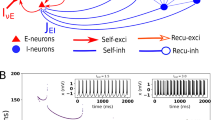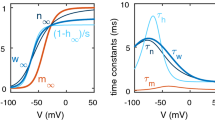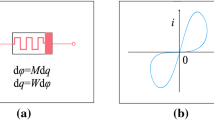Abstract
Statistical properties of spike trains as well as other neurophysiological data suggest a number of mathematical models of neurons. These models range from entirely descriptive ones to those deduced from the properties of the real neurons. One of them, the diffusion leaky integrate-and-fire neuronal model, which is based on the Ornstein–Uhlenbeck (OU) stochastic process that is restricted by an absorbing barrier, can describe a wide range of neuronal activity in terms of its parameters. These parameters are readily associated with known physiological mechanisms. The other model is descriptive, Gamma renewal process, and its parameters only reflect the observed experimental data or assumed theoretical properties. Both of these commonly used models are related here. We show under which conditions the Gamma model is an output from the diffusion OU model. In some cases, we can see that the Gamma distribution is unrealistic to be achieved for the employed parameters of the OU process.


Similar content being viewed by others
References
Abundo M (2012) An inverse first-passage problem for one-dimensional diffusions with random starting point. Stat Probab Lett 82:7–14
Atkinson KE (1989) An introduction to numerical analysis, 2nd edn. Wiley, New York
Avila-Akeberg O, Chacron MJ (2011) Nonrenewal spike train statistics: causes and functional consequences on neural coding. Exp Brain Res 210:353–371
Baker SN, Lemon RN (2000) Precise spatiotemporal repeating patterns in monkey primary and supplementary motor areas occur at chance levels. J Neurophysiol 84:1770–1780
Benda J, Maler L, Longtin A (2010) Linear versus nonlinear signal transmission in neuron models with adaptation currents or dynamic threshold. J Neurophysiol 104:2806–2820
Berger T, Levy WB (2010) A mathematical theory of energy efficient neural computation and communication. IEEE Trans Inf Theory 56:852–874
Buonocore A, Caputo L, Nobile AG, Pirozzi E (2015) Restricted Ornstein–Uhlenbeck process and applications in neuronal models with periodic input signals. J Comput Appl Math 285:59–71
Burkitt AN (2006) A review of the integrate-and-fire neuron model: II. Inhomogeneous synaptic input and network properties. Biol Cybern 95:97–112
Chacron MJ, Pakdaman K, Longtin A (2003) Interspike interval correlations, memory, adaptation, and refractoriness in a leaky integrate-and-fire model with threshold fatigue. Neural Comput 15:253–278
Chen X, Cheng L, Chadam J, Saunders D (2011) Existence and uniqueness of solutions to the inverse boundary crossing problem for diffusions. Ann Appl Probab 21:1663–1693
Farkhooi F, Strube-Bloss MF, Nawrot MP (2009) Serial correlation in neural spike trains: experimental evidence, stochastic modeling, and single neuron variability. Phys Rev E 79:021905
Gourevitch B, Eggermont JA (2007) A nonparametric approach for detection of bursts in spike trains. J Neurosci Methods 160:349–358
Inoue J, Sato S, Ricciardi LM (1995) On the parameter estimation for diffusion models of single neurons activities. I. Application to spontaneous activities of mesencephalic reticular formation cells in sleep and waking states. Biol Cybern 73(3):209–221
Iolov A, Ditlevsen S, Longtin A (2014) Fokker–Planck and Fortet equation-based parameter estimation for a leaky integrate-and-fire model with sinusoidal and stochastic forcing. J Math Neurosci 4:4
Jolivet R, Lewis TJ, Gerstner W (2004) Generalized integrate-and-fire models of neuronal activity approximate spike trains of a detailed model to a high degree of accuracy. J Neurophysiol 92:959–976
Jones DL, Johnson EC, Ratnam R (2015) A stimulus-dependent spike threshold is an optimum neural coder. Front Comput Neurosci 9:61
Kang K, Amari S (2008) Discrimination with spike times and ISI distributions. Neural Comput 20:1411–1426
Kepler TB, Abbott LF, Marder E (1992) Reduction of conductance-based neuron models. Biol Cybern 66:381–387
Kistler WM, Gerstner W, van Hemmen JL (1997) Reduction of the Hodgkin–Huxley equations to a single-variable threshold model. Neural Comput 9:1015–1045
Kobayashi R, Tsubo T, Shinomoto S (2009) Made-to-order spiking neuron model equipped with a multi-time scale adaptive threshold. Front Comput Neurosci 3:9
Koyama S, Kostal L (2014) The effect of interspike interval statistics on the information gain under the rate coding hypothesis. Math Biosci Eng 11:63–80
Lansky P, Sato S (1999) The stochastic diffusion models of nerve membrane depolarization and interspike interval generation. J Peripher Nerv Syst 4:27–42
Lansky P, Ditlevsen S (2008) A review of the methods for signal estimation in stochastic diffusion leaky integrate-and-fire neuronal models. Biol Cybern 99:253–262
Levine MW (1991) The distribution of the intervals between neural impulses in the maintained discharges of retinal ganglion-cells. Biol Cybern 65:459–467
Lindner B (2004) Moments of the first passage time under external driving. J Stat Phys 117:703–737
Maimon G, Assad JA (2009) Beyond poisson: increased spike-time regularity across primate parietal cortex. Neuron 62:426–440
Omi T, Shinomoto S (2011) Optimizing time histograms for non-Poissonian spike trains. Neural Comput 23:3125–3144
Peskir G (2002) Limit at zero of the Brownian first-passage density. Probab Theory Relat Fields 124:100–111
Plesser HE, Geisel T (2001) Stochastic resonance in neuron models: endogenous stimulation revisited. Phys Rev E 63:031916
Rajdl K, Lansky P (2015) Stein’s neuronal model with pooled renewal input. Biol Cybern 109:389–399
Ricciardi LM, Sacerdote L (1979) The Ornstein–Uhlenbeck process as a model for neuronal activity. Biol Cybern 35:1–9
Sacerdote L, Zucca C (2003) Threshold shape corresponding to a gamma firing distribution in an Ornstein–Uhlenbeck neuronal model. Sci Math Jpn 8:375–385
Sacerdote L, Giraudo MT (2013) Stochastic integrate and fire models: a review on mathematical methods and their applications. Lect Notes Math Stoch Biomath Models Appl Neuronal Model 2058:99–148
Sacerdote L, Villa AEP, Zucca C (2006) On the classification of experimental data modeled via a stochastic leaky integrate and fire model through boundary values. Bull Math Biol 68(6):1257–1274
Segev I (1992) Single neuron models—oversimple, complex and reduced. Trends Neurosci 15:414–421
Shimokawa T, Pakdaman K, Takahata T, Tanabe S, Sato S (2000) A first-passage-time analysis of the periodically forced noisy leaky integrate-and-fire model. Biol Cybern 83:327–340
Shimokawa T, Koyama S, Shinomoto S (2010) A characterization of the time-rescaled gamma process as a model for spike trains. J Comput Neurosci 29(1–2):183–191
Shinomoto S, Sakai Y, Funahashi S (1999) The Ornstein–Uhlenbeck process does not reproduce spiking statistics of cortical neurons. Neural Comput 11:935–951
Smith PL (2010) From poisson shot noise to the integrated Ornstein–Uhlenbeck process: neurally principled models of information accumulation in decision-making and response time. J Math Psychol 54:266–283
Soteropoulos DS, Baker SN (2009) Quantifying neural coding of event timing. J Neurophysiol 101:402–417
Stein RB (1965) A theoretical analysis of neuronal variability. Biophys J 5:385–386
Thomas PJ (2011) A lower bound for the first passage time density of the suprathreshold Ornstein-Uhlenbeck process. J Appl Probab 48(2):420–434
Tuckwell H (1988) Introduction to theoretical neurobiology. Cambridge University Press, Cambridge
Tuckwell HC, Richter W (1978) Neuronal interspike time distributions and estimation of neurophysiological and neuroanatomical parameters. J Theor Biol 7(1):167–183
Uhlenbeck GE, Ornstein LS (1930) On the theory of Brownian motion. Phys Rev 36:823–841
Vilela RD, Lindner B (2009) Are the input parameters of white noise driven integrate and fire neurons uniquely determined by rate and CV? J Theor Biol 257:90–99
Yannaros N (1988) On Cox processes and Gamma-renewal processes. J Appl Probab 25:423–427
Zucca C, Sacerdote L (2009) On the inverse first-passage-time problem for a Wiener process. Ann Appl Probab 19(4):1319–1346
Author information
Authors and Affiliations
Corresponding author
Additional information
This work was supported by the Institute of Physiology RVO:67985823, by the Czech Science Foundation project 15-08066S and University of Torino local Grant: ZUCC_RIC_LOC_15_01.
Rights and permissions
About this article
Cite this article
Lansky, P., Sacerdote, L. & Zucca, C. The Gamma renewal process as an output of the diffusion leaky integrate-and-fire neuronal model. Biol Cybern 110, 193–200 (2016). https://doi.org/10.1007/s00422-016-0690-x
Received:
Accepted:
Published:
Issue Date:
DOI: https://doi.org/10.1007/s00422-016-0690-x




